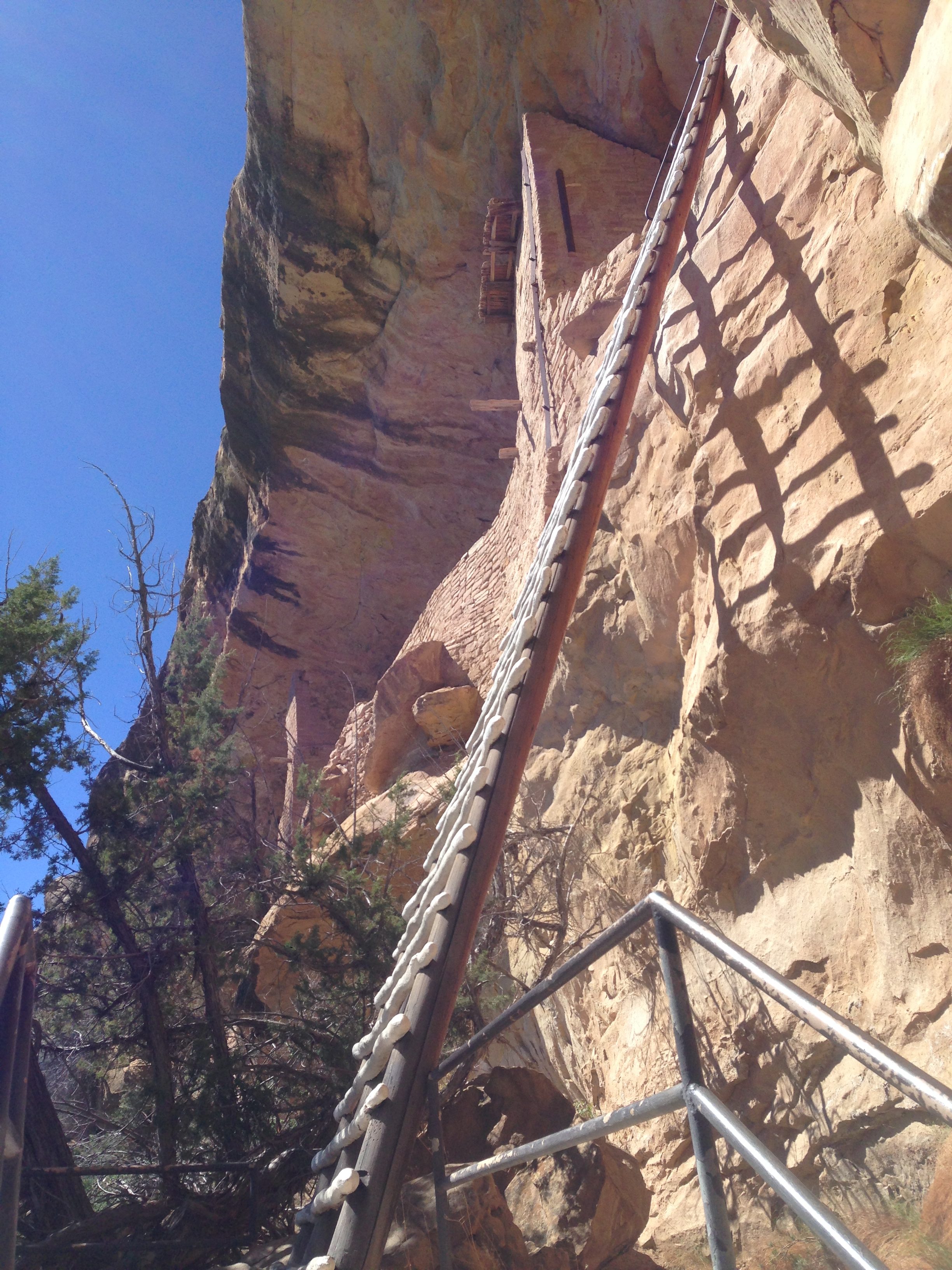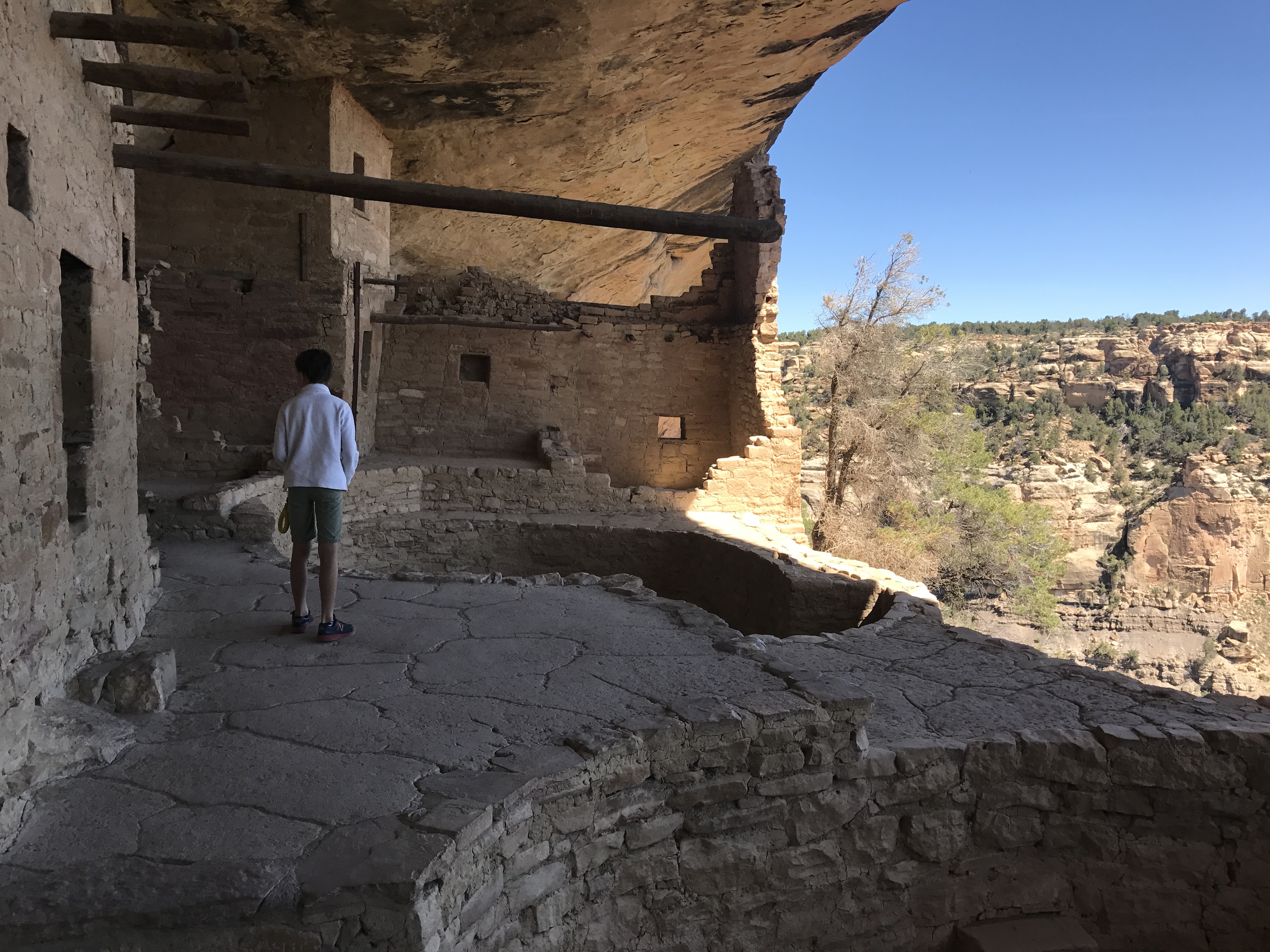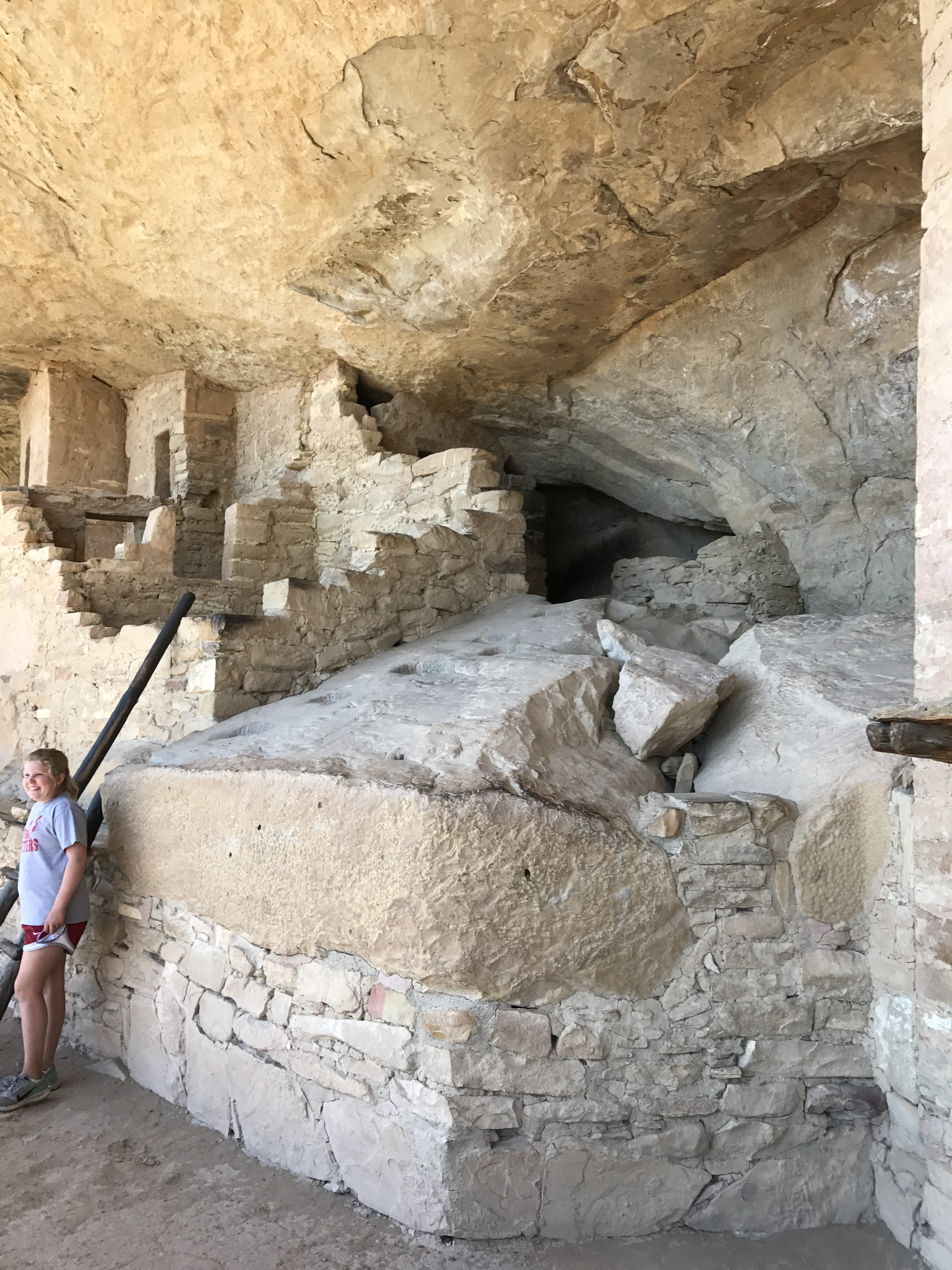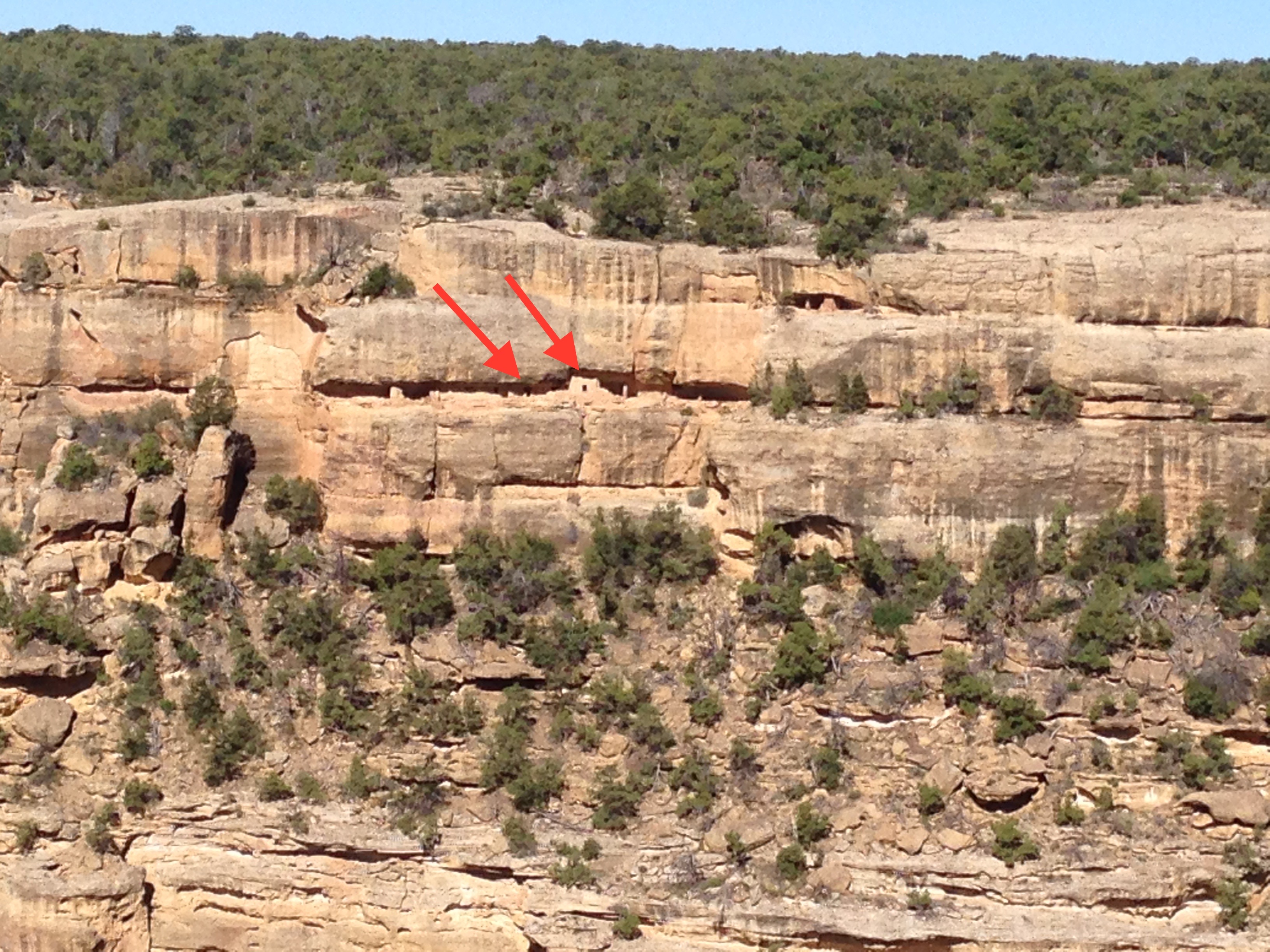A few weeks ago (in late May), I got a chance to visit a place I’ve wanted to go to for a long time: the Anasazi cliff dwellings. The Anasazi were a Native American tribe (group; people) that lived in the Southwestern part of present-day (what is now) United States in about 1100 A.D. A cliff is the very steep side of a mountain, and a dwelling is a home.
In the southwestern corner of Colorado is Mesa Verde National Park. A national park is a place of natural beauty or importance that is protected by the United States federal (national) government. Mesa Verde is where you will find some of the best preserved (protected from damage) cliff dwellings dating back to the (from the years) 1100 and 1200s A.D.
Nobody knows for sure why, but in the 1190s, the Anasazi, who had lived on the top of the mesa (mountain with a flat top) up to this time, moved to new dwellings they built underneath (below) the hanging cliffs (part of the cliff without supporting rock underneath).
Some of the structures were small and had only one room, probably used for storage (keeping things for later use). Others were as large as 150 rooms, large enough for an entire village (community of people living together). While the Anasazi continued to farm above, they lived below. One theory (guess based on the available evidence) is that they were protecting themselves from other hostile (unfriendly; wanting to harm them) groups.
Again, no one knows why, but by the late 1270s, the Anasazi started moving south. They are the ancestors (people who came before) of the Pueblo Native Americans in New Mexico and Arizona today. By 1300, a little more than 100 years after they were built, the Anasazi cliff dwellings had been abandoned (with no one living there anymore).
I was able to go on a tour of one of these cliff dwellings. To reach the dwelling, we had to climb down a tall ladder (see below), crawl (move on hands and knees) through holes in the rock, and scramble (move quickly over rough ground) over the side of the mountain. It was not as strenuous (requiring a lot of physical effort) as it sounds and quite safe, of course. I am not Tom Cruise!

Here are a couple of the photos I took of the “Balcony House,” one of several dwellings that visitors can tour. (A balcony is a place you can step out onto on the outside of a house, and this dwelling was called the “Balcony House” because it had a rock formation (rock structure) shaped like a balcony.)

 Below is a photo of the “Cliff Palace.” A palace is a very large home where rich or important people live, such as kings or queens. I couldn’t tour this dwelling because it wasn’t open for tours yet.
Below is a photo of the “Cliff Palace.” A palace is a very large home where rich or important people live, such as kings or queens. I couldn’t tour this dwelling because it wasn’t open for tours yet.

Finally, can you see the windows in this photo? There are dwellings behind them. This gives you an idea of the scale (size compared to other things) of these dwellings and the surrounding cliffs.
 How did the Anasazi reach these dwellings? The best guess (belief based on little or limited evidence) is that they used ropes (long pieces of strong fabric) and were excellent rock climbers, perhaps using only their hands and feet to climb up and down.
How did the Anasazi reach these dwellings? The best guess (belief based on little or limited evidence) is that they used ropes (long pieces of strong fabric) and were excellent rock climbers, perhaps using only their hands and feet to climb up and down.
If you ever get a chance to visit Mesa Verde National Park, I highly recommend it. But be sure to get your tour tickets a few days early. There are always more people who want to take tours then there are tickets.
~ Lucy
Hi Lucy,
Glad to meet you again.
Very interesting your visit and thank you for the wonderful photos.
I like to visit such of places full of history at least looking at the photos.
I remember that and Jeff told us about Mesa Verde National Park
at the English Cafe.
Thank you and…
Best wishes,
Tania
Hi,
Do you mind if I continue talking about the book that I am reading?
It’s about “The Shared Wisdom of Mothers and Daughters” by A. Stoddard.
Some of her advice but translated by me.
If you want to feel rich, count all things from your life that you cannot buy
with money.
Never lose your strength and freshness.
Never behave like old people.
We grow children to be independent and not to take care of us.
Hi,
Be calm. Be patient. Life is nice and it will remain nice.
Never forget that the life is short.
Hi,
Maybe all our blog friends are in vacation.
We are waiting for their news.
Have a good time,
Tania
Hi,
I have followed the Warren’s advice and I have accessed
the Seth’s blog.
Interesting, short posts and easy to read and learn.
I’ll try to find and his books.
Thank you.
Best wishes,
Tania
Hi,
“The biggest hesitation is the fear of an open door.”
“The biggest challenge is the question we ask ourselves:
Then what will I do?”
From Seth’s blog post
Hi,
Yes. I have the same question: Then what will I do?
Hi,
Reading Look for the Helpers, Warren’s post…
Glad to discover Fred Rogers and his “Mr. Rogers’ Neighborhood” , children’s television program, at the Warren’s advice.
I can understand his words.
He speaks slowly, warmly like Jeff.
Thank you.
Hey Lucy ,
How have you been
To my best of recollection ,I think jeff covered the dwellings in one of the English cafe episodes.
Sigh ,good old days.
It was way before eslpod goes rouge on us 🙂
If u ask me ,the big puzzler here is not how did they reach the cave but how did they carve those rock and stones in the first place. U know ,to make those so called dwellings.
What tools did they use.
And how come the ceilings didn’t cave in
I don’t see any man-made beams shoring up the ceilings or sth
Even if is the work of nature.by that I mean even if they already being there.
Still ,the place had called for some modification to make it suitable for living
the pics u took suggest some man-made adjustment here or there.
It seems they did take some tools to the rocks
So
How did on earth they do it.
Well ,can’t be done by barehand.
Any insight there Lucy ?
We have a riddle on our hands Lucy
How on earth did they pull the feat.
Yours
🙂
Pete
Hi dear Lucy
Now ,that u mentioned it people back then both sex must have had hard bodies 🙂 all tuned up with abbs and definition. Well , some might say asides from a healthy strong life their life style might had been promoting, it is an ideal look in people. U know ,all masculine and tuned up.
Well ,I wanna go on a limb here and say ” not necessarily. ”
In particularly for women.
But
Think about it
They must have all had rock body with washboard stimach and hard peks. Are u kidding me commuting -well in their case -rock climbing in and out of ur place every single day two or three times
Man
Think about the money could they have made in Hollywood.
No wonder ,with all their mammoth beinge eating they never-like us – had clostrol or blood pressure problems.:))))
I bet non of them were diabetic
Always nice chatting with u
Ur groupie
🙂
Pete
I keep reading through the materials offered at Lucy’s post _the images and everything. I can’t get over the difficulty prehistoric people were enduring even for a simple commute to and from their habitats.
Man
Unless ,rock climbing was in vogue back then, leaving and returning home must have been very dreadful. 🙂
I ,for one ,would loose sleep over it.
My real fascination though is regarding the place they were residing. how on earth did they dig though rock and dirt. Even if the nature did the bidding for then still
The place needed some finishing touch to make it livable.
The best analogy -I think – in the modern world, is to live in a fixer and upper house and do nothing about it.
I don’t know man
Lucy’s post got me thinking about how rough prehistoric people had it. And,how good we have it. Think about it ,back then ,they had to go the extra mile to whet the smallest basic needs as opposed to the comtemperory people who have it all without lifting a finger.
Lucky us
🙂
Pete
Tania, how are you my girl?
I have read some of your posts, it seems to me you are really sad and feel
alone.
Just shake hands, more or less I felt the same a year ago, but Cuca is going
quite well and of course she is alive and better that she was here at home
last year or the year before.
It seems that the sacrifice was really for good, very good indeed.
Yes, I am alone here at home but it is absolutely different.
My sister went away in Mach and in April my best friend Camila went away also, too hard but such is life.
Every day we pass alive we need to say thanks my God and so a day after another and don´t think nothing more, not even about next week or even less next month.
My best to you dear friend Tania, please touch to me with the mail.
emiliano